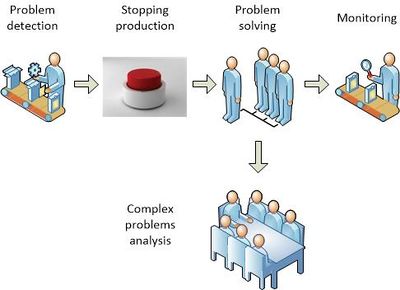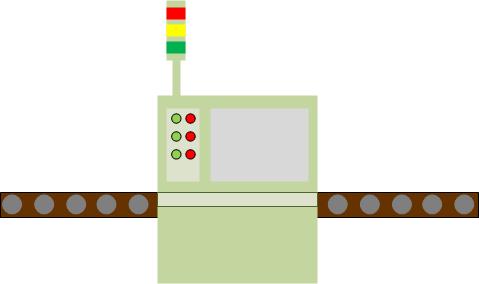Andon: Difference between revisions
(The LinkTitles extension automatically added links to existing pages (<a target="_blank" rel="noreferrer noopener" class="external free" href="https://github.com/bovender/LinkTitles">https://github.com/bovender/LinkTitles</a>).) |
m (Infobox5 upgrade) |
||
| (3 intermediate revisions by 3 users not shown) | |||
| Line 1: | Line 1: | ||
'''Andon''' is a visual [[system]] that notifies managers and workers of a problem with [[production]] [[process]]. It can be in form of large [[board]] with light signals or, more recently, large LCD screen showing [[information]] about [[quality]] problems. The andon system is linked with equipment that is able to detect problems or even stop the production. The famous equipment is Toyota [[andon cord]]. Every worker could pull the cord and stop the production. Nowadays, it is more common to use buttons. | '''Andon''' is a visual [[system]] that notifies managers and workers of a problem with [[production]] [[process]]. It can be in form of large [[board]] with light signals or, more recently, large LCD screen showing [[information]] about [[quality]] problems. The andon system is linked with equipment that is able to detect problems or even stop the production. The famous equipment is Toyota [[andon cord]]. Every worker could pull the cord and stop the production. Nowadays, it is more common to use buttons. | ||
| Line 68: | Line 52: | ||
* It is sometimes difficult to interpret the data presented on the andon board, making it difficult to determine the best course of [[action]]. | * It is sometimes difficult to interpret the data presented on the andon board, making it difficult to determine the best course of [[action]]. | ||
== | {{infobox5|list1={{i5link|a=[[Andon board]]}} — {{i5link|a=[[Andon cord]]}} — {{i5link|a=[[Jidoka]]}} — {{i5link|a=[[Attendance management]]}} — {{i5link|a=[[Computer integrated manufacturing]]}} — {{i5link|a=[[Failure Mode and Effects Analysis]]}} — {{i5link|a=[[Quality control]]}} — {{i5link|a=[[Line balancing]]}} — {{i5link|a=[[5S method]]}} }} | ||
[[ | |||
==References== | ==References== | ||
Latest revision as of 14:15, 17 November 2023
Andon is a visual system that notifies managers and workers of a problem with production process. It can be in form of large board with light signals or, more recently, large LCD screen showing information about quality problems. The andon system is linked with equipment that is able to detect problems or even stop the production. The famous equipment is Toyota andon cord. Every worker could pull the cord and stop the production. Nowadays, it is more common to use buttons.
Also the machines can have automatic detectors. That solution is called Jidoka and was developed by Toyota in early XX century as one of the first elements of Toyota production system.
Andon is one of Lean manufacturing pillars, together with: Konnyaku stone, Poka yoke, Hansei, Jidoka, Just in time, Heijunka, Kaizen, Genchi genbutsu, Nemawashi.
Andon system
In case of any problem related to process, following procedures apply.
Case 1. Worker detects problem
- Worker detects problem. It can e.g.: lack of part, wrong colour of the part, defected element.
- Worker uses andon cord or button to signal the problem.
- The production is automatically stopped.
- The team of workers and managers meet and decide what to do with the problem. They have only limited time to solve it.
- When the time passed, the production has to be started again.
Case 2. Machine detects problem
- Machine detectors find quality problem
- The machine automatically stops and sends signal to andon board or turns on signal light
- The worker tries to solve the problem
- If the worker fails, he calls the team to solve the problem.
The method is not intended to solve sophisticated problems. It's purpose is to make high quality production possible again. Any more complex problems have to be solved separately.
Andon board
Originally signal lights were installed on the machines. However, when the production lines were implemented, it was not convenient. Therefore, the andon cord idea was developed. But the signal should be passed somehow to all interested people. The large board with signal lights was usually installed in a place visible for everyone on the production floor. When the computer and intranet era came, those board were replaced by information systems. Now every interested employee and manager can see immediate alert on his computer or smartphone.
Examples of Andon
- Andon Cord: The Andon cord is one of the most well-known andon systems. Developed by Toyota in 1950s, it was a cord that workers could pull if they noticed a problem in the production process. This would immediately notify management, who would come and address the issue. The cord is still used in some applications, but has been mostly replaced by other andon systems.
- Visual Displays: These are large displays, usually LCD screens, that provide information about the production process and any errors or issues that may occur. They are often color-coded to indicate the severity of the issue and can be used to alert workers and managers alike.
- Audible Alarms: Audible alarms are another common type of andon system. These are typically used to indicate when a machine is malfunctioning or when a quality issue has been detected. They are also used to alert workers to any issues that may arise during the production process.
- Lights: Lights are a simple and cost-effective way to indicate when there is an issue with a machine or the production process. They can be used to alert both workers and management of any issues and are often used in conjunction with other andon systems.
Advantages of Andon
A Andon system helps to improve production processes by providing a visual tool that notifies workers and managers of a problem. The following are some of the advantages of using an andon system:
- Increased visibility: Andon systems provide a visual representation of production issues, making it easier to identify issues quickly and accurately.
- Improved communication: The andon system helps ensure that everyone in the production process is aware of any issues that may arise, allowing for faster response times and better problem-solving.
- Improved efficiency: Andon systems allow workers to quickly identify and resolve issues, allowing for less downtime and faster production.
- Improved quality: Andon systems allow for better quality control, as workers can address issues quickly and efficiently.
- Improved safety: Andon systems help to prevent accidents and injuries by quickly alerting workers to any issues that may arise.
Limitations of Andon
- Andon systems require significant investment in hardware and software, as well as training and regular maintenance in order to ensure proper functioning.
- The cost of the system is often prohibitive for smaller companies and businesses.
- Andon can only detect problems which are programmed into it. It cannot detect problems which are not already identified.
- The system is dependent on the accuracy and quality of the data entered by the user.
- The system cannot detect human errors or safety risks, such as improper use of equipment.
- It is difficult to keep track of all the production processes and all the workers involved, making it hard to identify the root cause of a problem.
- It is sometimes difficult to interpret the data presented on the andon board, making it difficult to determine the best course of action.
| Andon — recommended articles |
| Andon board — Andon cord — Jidoka — Attendance management — Computer integrated manufacturing — Failure Mode and Effects Analysis — Quality control — Line balancing — 5S method |
References
- Kemmer S.L., Saraiva M.A., Heineck L.F.M (2006) The use of andon in high rise building, Implementation and Performance Measurement, Proceedings
- da Silva, A.M. (2000) The Andon system: designing a CSCW environment in a lean organization, Inst. of Comput. & Nied.
- Tang C.S., Chan C.Y., Yung K.L (2006) The Development of a Generic Technique for Flow Line Monitoring, Engineering Letters, 14:1
Author: Slawomir Wawak

